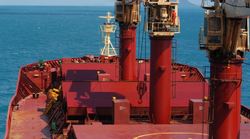Capesize gains spread to other segments

Recent gains in the capesize market have spread to other dry bulk segments, especially the panamax market, leading the Baltic Dry Index, a benchmark indicator for investors, to reach its highest level since January 2014.
The capesize segment, which has the highest weighting in the BDI at 40%, has soared to the most since December 2017, while the panamax market, which has a weighting of 30%, has not seen these levels since December 2013.
THE BALTIC DRY INDEX WAS UP AT 1,816 POINTS ON THURSDAY, ITS HIGHEST LEVEL SINCE EARLY JANUARY 2014.
GAINS seen in the capesize market over recent days is trickling down into other segments, leading the Baltic Dry Index, a benchmark indicator for investors, to reach its highest level since January 2014.
According to Deutsche Bank, the dry bulk markets are moving higher, led by capesize, which has seen the “sharpest recovery” on record.
The gains in the capesize market, which has the most weighting in the calculation of the BDI at 40%, have come about as activity continues to ramp up from Brazil. On June 19, Vale said it was allowed to re-open its 30m tonnes per year Brucutu iron ore mine.
The capesize market is also benefiting from “increased activity out of South Africa as other regions are taking advantage of elevated iron ore prices to ramp production and fill the Vale void,” Deutsche’s research team said in a report, adding that they expected further improvements to come.
The average weighted capesize time-charter on the Baltic Exchange climbed to $27,389 per day at the close on Friday, the highest level since December 13, 2017.
The BDI was up at 1,865 points on Friday, its highest level since early January 2014.
Mid-sized bulkers were also firming due to “strong demand out of the Atlantic” combined with a limited availability of vessel supply, especially on coal routes, according to Deutsche.
Coal activity was seen ramping up, which is offsetting weakness in grains trades, it said, noting that US grain exports dropped 30% to 7.5m tonnes in the week ended June 27 versus a year earlier, as the US-China trade tensions continue to bite.
According to Fearnleys, fundamentals for the “big ships remain robust, with all major miners back on stage, enjoying historically high ore prices and pushing out as much as possible”.
“Fronthaul and transatlantic trades remain the brightest spots, where a shortage of available early units has forced major Brazilian exporters to split capesize stems destined for China into panamax lots at high cost to secure tonnage,” the brokerage said in a note.
“The Atlantic still shows no sign of slowing,” the Baltic Exchange said of the panamax market.
“Panamaxes fixing for minimum durations within the Atlantic on prompt positions are setting the bar ever higher as the limited tonnage supply continues to cause charterers problems,” it said in a note, adding that South America has recently witnessed an upturn in rates, as had the Pacific region, with period interest strong in all areas.
The average weighted panamax time-charter on the Baltic Exchange climbed to $15,536 per day at the close on Friday. That’s the highest since December 2013.
Supramax earnings have meanwhile been rising since June 13 to $10,112 per day on the Baltic Exchange on Friday from $8,094. The market was benefiting from strong demand in the Black Sea, according to Fearnleys.